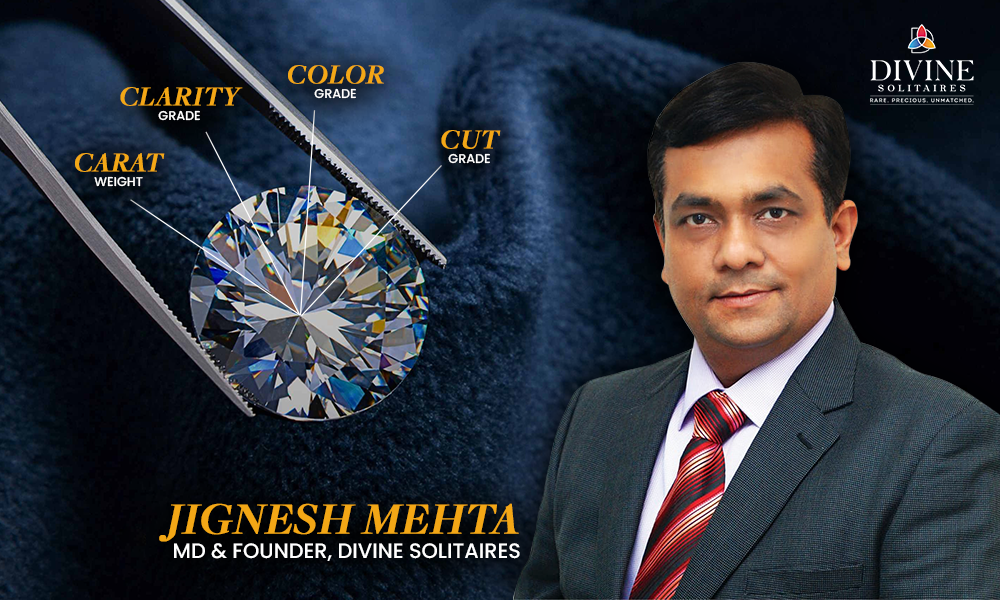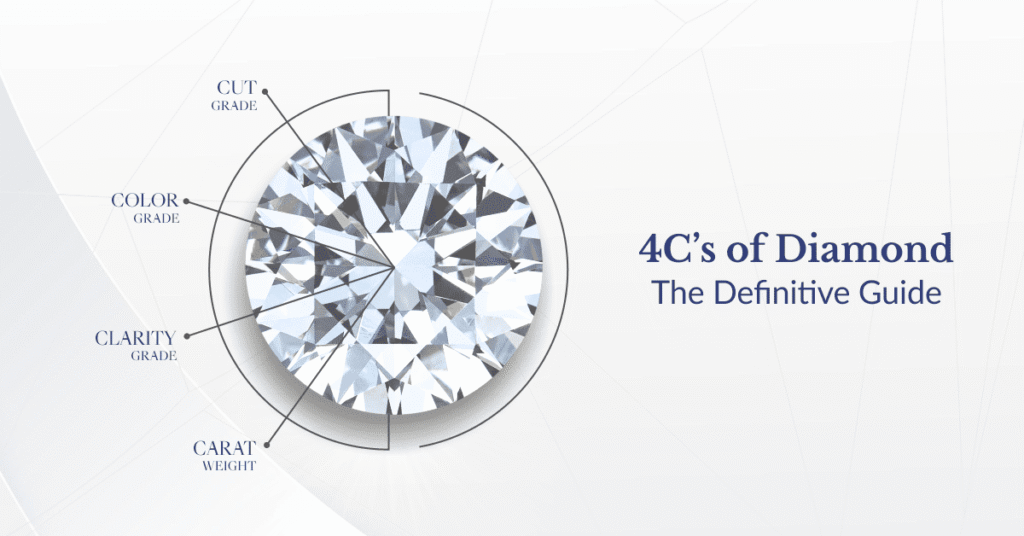By Invitation
Why a Natural Diamond Solitaire transcends the 4Cs
Jignesh Mehta – MD & Founder, Divine Solitaires

In a world of transient trends and mass-produced possessions, there remain a few timeless treasures that carry a value far beyond their material worth. A natural diamond solitaire is one such enduring symbol — an extraordinary gift of nature that offers more than just aesthetic appeal or technical excellence. It represents emotion, legacy, and an investment destined to shine through generations.

While the classic 4Cs — Cut, Clarity, Colour, and Carat — have long been the benchmarks of diamond selection, today’s discerning consumers are seeking more. Conscious buying behaviours and evolving consumer preferences are redefining luxury, and in this dynamic environment, the natural diamond solitaire continues to hold a singular, unassailable allure.
Emotional and Legacy Value: A Diamond Beyond Compare
A diamond purchase is rarely an impulse. It is often tied to significant personal milestones — engagements, anniversaries, or achievements that mark new beginnings. Increasingly, consumers are choosing solitaires not only to celebrate relationships but also to honour their own journey. Be it career milestones, personal growth, or financial independence, the emotional resonance attached to a solitaire makes it a cherished possession.
Legacy gifting is another rising trend. Families are investing in solitaire diamonds not merely as heirlooms but as financial assets for the next generation. These stones carry the dual value of sentiment and security, ensuring the bond of familial love endures alongside wealth preservation.
At Divine Solitaires, we have observed a deepening of this emotional connection over the years, as buyers seek possessions with meaning, permanence, and personal significance.
Light, Precision, and the Art of Brilliance
A diamond’s true magic lies not in its size but in the way it interacts with light. Its brilliance, fire, and scintillation, collectively termed as light performance which determine its visual splendour. Every cut, every facet, and every angle contribute to this captivating play of light.
At Divine Solitaires, we use advanced optical analysis to guarantee that every diamond meets the highest standards of light performance. Going beyond the conventional triple excellent cut, each of our stones showcases the perfect 8 Hearts and 8 Arrows pattern — a hallmark of flawless symmetry, alignment, and proportion that maximises sparkle under every light and setting.
Integrity in Certification and Grading
For the modern luxury consumer, fewer but finer possessions define true indulgence. Precision, authenticity, and transparency have become non-negotiable expectations. Divine Solitaires ensures that every solitaire undergoes a rigorous 123 parameters quality check process aligned with the highest global standards.
Our commitment to trust is further reinforced through detailed quality certification and India’s first-ever Nationwide Standard & Price Index for solitaires. This pioneering initiative brings unprecedented structure, consistency, and credibility to solitaire pricing — offering buyers the reassurance of lasting value and resale integrity.
The Unreported Factors:
Certain diamond characteristics like Hearts & Arrows, Luster, Overtones, Light Performance remain unseen to the untrained eye but significantly influence both aesthetic appeal and investment value. Excessive fluorescence, for example, can cause a diamond to appear hazy under UV light, while internal graining may affect its visual purity.
At Divine Solitaires, our meticulous curation process excludes diamonds with such imperfections. Our selection process ensures that every solitaire we offer upholds the highest standards of quality and educating consumers along the way about these finer, often overlooked nuances of diamond selection.
A Symbol in Beauty, Meaning, and Legacy
A Divine Solitaires diamond is more than an ordinary diamond. It is a symbol of technical brilliance, ethical assurance, and enduring emotional significance. Every stone is a promise to shine not just in the light, but through the memories, milestones, and moments that shape a lifetime.
As the world of luxury evolves, one truth remains: a natural diamond solitaire will always transcend its 4Cs, holding its place as an emblem of beauty, meaning, and legacy.
By Invitation
The Great Jewellery Retail Reset: Are You Ready for What’s Coming Next?
By Shivaram A,Retail Business Mentor

As gold prices fluctuate and customer mindsets evolve, the jewellery retail business stands at a turning point. Those who adapt with guidance will thrive — others may struggle to stay relevant.
Over the last year, jewellers across India have been living through a storm of uncertainty. Gold rates have risen, fallen, and risen again — shaking customer confidence and confusing buying behaviour. While many stores reported higher sales values during festive months, the actual number of pieces sold told a different story.
Customers were walking in — but walking out with fewer items. The same budgets, smaller volumes. The emotional connect with gold remained, but the buying intent was changing quietly beneath the surface.
A Shift in Buying Behaviour: Lighter, Smarter, More Selective
Jewellery, once seen as a long-term investment, is now also viewed through the lens of practicality and personal style. The younger buyer isn’t chasing weight anymore; they’re chasing meaning, design, and comfort.
Heavy necklaces and bangle sets have become slower movers, while rings, earrings, and lightweight chains are finding quick takers. Even as the “value” of inventory rises with gold prices, the “velocity” of sales — how quickly products move — has slowed down.
This creates an illusion of growth on paper but a challenge in reality: slower rotation, tighter margins, and customers whose expectations are changing faster than most jewellers are prepared for.
Two Customers, Two Worlds
At one end are traditional families — loyal, price-conscious, and deeply rooted in their relationship with their family jeweller. At the other end stands the new-age urban customer — salaried, educated, and brand-aware.
This second group is the real disruptor. They don’t see gold as an emergency asset but as an accessory that defines lifestyle. They browse online, compare designs across stores, and choose convenience over custom.
For them, jewellery is fashion — not finance. And that single shift is rewriting the rules of the game.

Competition Is Heating Up
As independent jewellers fight to maintain margins, larger chains are expanding quietly — opening new showrooms, entering Tier 2 and Tier 3 towns, and capturing the very customers smaller stores once depended on.
Adding to the mix are non-jewellery investors and new entrants drawn by the industry’s steady performance compared to other sectors. With over 10,000 new stores expected to open in the next few years, competition will only intensify.
This means the traditional family jeweller can no longer depend solely on legacy, relationships, or word-of-mouth. What’s needed now is strategy, structure, and smarter decision-making — powered by data, training, and mentorship.

Change Is Hard — But Help Is Available
Transitioning from a legacy business model to a modern retail approach isn’t easy. It involves rethinking everything from sales processes to staff mindset, from customer experience to inventory strategy.
But the good news is — you don’t have to do it alone.
Every successful transformation begins with one conversation — a discussion about where you are, what’s changing, and how to move forward one step at a time.
That’s where mentorship makes the difference. A seasoned guide can help you see patterns others miss, avoid expensive mistakes, and build a roadmap that’s realistic and sustainable.

Jewellery retail is evolving — and those who evolve with it will shine brighter in the years ahead.
While change is always tough, it is also necessary. The key is to take it step by step, guided by experience and insight.
If you’re wondering where to start or how to navigate the next phase of your business transformation — let’s talk.
-

 BrandBuzz7 hours ago
BrandBuzz7 hours agoMCA raises “small company” thresholds – up to ₹10 cr capital & ₹100 cr turnover from 1st December 2025, major relief for jewellery trade
-

 JB Insights8 hours ago
JB Insights8 hours agoWomen Leaders Driving the Luxury Renaissance
-

 National News12 hours ago
National News12 hours agoSHINESHILPI Announces the Launch of The Shine House, India’s Biggest B2B Jewellery Hub
-

 National News10 hours ago
National News10 hours agoTalla Jewellers Successfully Hosts Free Health Checkup Camp with Fortis Escorts Amritsar and Live For Others Foundation







